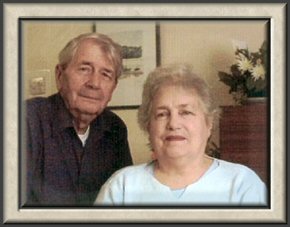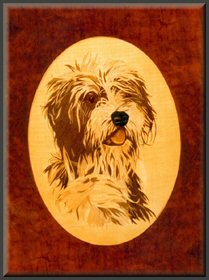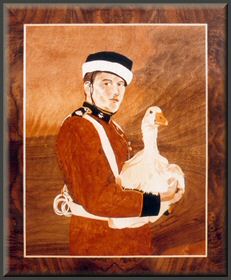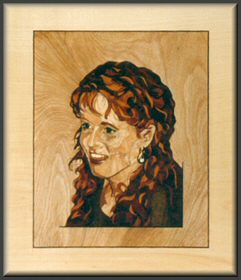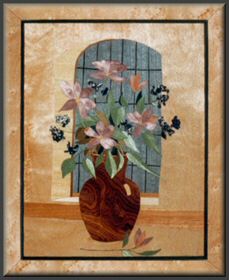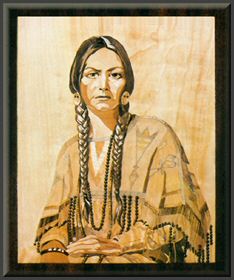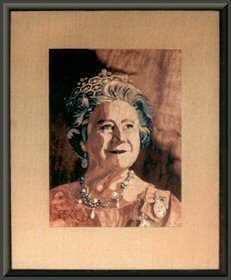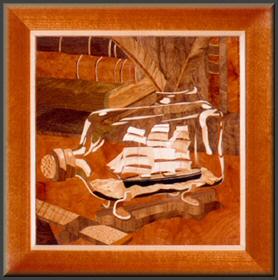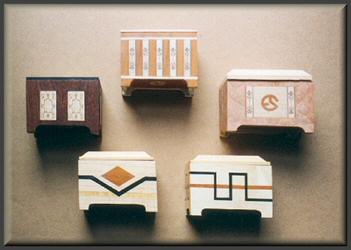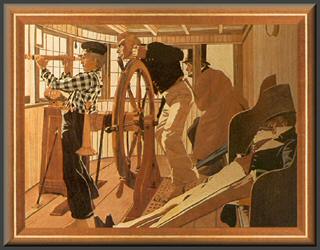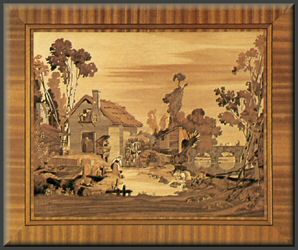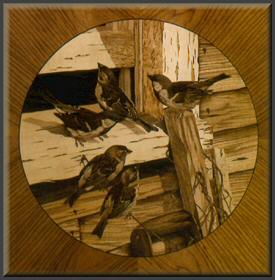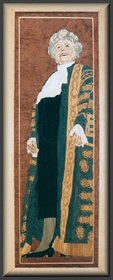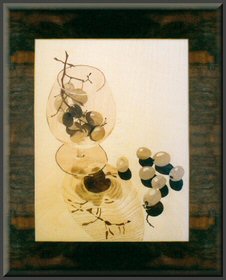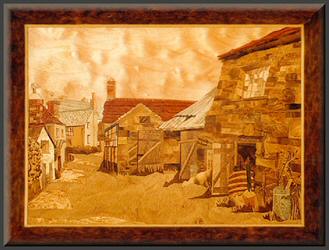|
 |
|
![]()
INTERVIEW NUMBER 5
Eddie: My background is an engineering one, designing and drawing large earth-moving vehicles of all types. The only woodwork experience I had was 'pattern making' at the Technical College. The feel and looks of finished wood has always appealed to me. With limited resources and no natural ability, I tried to make some boxes, and failed. I still cannot make one. Pauline spotted some marquetry kits in a local shop and brought me one as a present for Christmas 1963. To me it was a 'Painting by numbers' in wood. The instructions for the ‘Window’ method were gobbledy gook, as far as I was concerned so it had to be the overlap method, which I did understand. Pauline: I had not seen marquetry as pictures, only on items of antique furniture and boxes. I could not have told the difference between wood inlay to the old type decoupage, and was not very impressed. C: What attracted you both to this craft? Eddie:The attraction of marquetry was, unusual, it took limited space, produced a picture that others thought 'was clever as it was in wood'. It also helped awaken an artist feel for wood in me. Pauline: I had seen Eddie progress from kit pictures to making his own patterns up with the scraps of left over veneers, thinking how clever it all was. but we heard about a marquetry show in Bristol ( the Bristol National 1979) and was so surprised at the standard of work. On talking to a steward decided to go to the Bristol Group to find out more about it.
C: Were you inspired by anyone’s work you had seen? Eddie: I cannot recall seeing any other person’s marquetry until 1979/80, and then it was at the Bristol National. That means that I carried on doing marquetry for some seventeen years in isolation. I was overwhelmed by the standard of work at the National. I have seen many very good marquetarians work since, but always found it other peoples work more of a challenge to do better, than inspiring. C: Some people have a liking for one particular type or style of design. Do either of you have any particular preferences in designs and from where do you derive them? Eddie: As we are also deeply involved in a local Art Society, we have plenty of source material, although my preference is my own photographs, especially for miniatures. I have a great many art books but find that books of drawings are easier to convert. It is no secret that I have a great interest in portraits. Pauline: I just find pictures in magazines, Newspapers, Own Photos. Flowers and still life are from my own paintings.
C: Why do you choose to do any particular piece of marquetry? Is it for yourself, a present, because it is a fascinating design or is it for the challenge? Eddie: To select a piece of work, it must instantly strike me as a picture that has appeal for me - next, that it is possible to convert to marquetry. It must contain some challenges. C: Having two marquetarians in one household obviously does not cause you any problems but do you help each other with suggestions or ideas or do you work independently? Eddie: We do look at each other’s work and offer advice, mainly when the other asks. This is generally about choices of woods. Pauline: Eddie and myself work separately, and solve our own problems, only interfering on request. C: Do you derive more pleasure from creating a picture or an applied piece? Eddie: I would love to do applied work, but somehow it does not seem to work out. Perhaps I should invest in better boxes. C: Is marquetry a definite relaxation for you? Eddie: I get great pleasure out of marquetry, definitely since I decided some years ago it is a hobby, not a passion. Now I do it to satisfy onl y me, others are welcome to look and make comments, if they must. I do find it relaxing and try to listen to music (Light classics) whilst doing it. Pauline: I have to work hard at marquetry often changing bits several times, but the concentration takes my mind off other things (like the voice saying 'whats for dinner') and (when are you going to turn my trousers up)
C: What piece of advice would either of you give to a beginner just starting out on his or her first piece of work? Eddie: Advice to a beginner! Listen to others but do your marquetry to suit yourself. at a speed that suits you and to a condition that you are happy with. Do not listen to too many others, it will confuse you. I started with Richard Shellard and it was all very heavily competitive, to the extent that in the end the pleasure went from marquetry for me. Several times I nearly stopped doing marquetry, because no matter how hard I tried, sweated and strained someone would come along and blast my efforts. I am often shocked to find our Rose Bowl Winners being heavily criticised. Perhaps the fact that I saw what I was doing as pictures and others saw them as pieces of work, made the difference. Pauline: I would advise any beginner to start on a simple small subject, so as they go through all the parts of starting to finishing. A complicated picture will drag on too long. C: I know you are both very much involved in painting so does this have an influence on your marquetry and if so, in what way? Eddie: As you say we are both into painting and I consider it a great help. It allows me, when looking at a picture, to decide if I want to leave any part out. Some marquetarians put every detail in, good luck to them, but it is not always necessary. It also helps me on layout and presentation. It also allows me to display a few pictures a year to the public, exhibiting with our local Art Society. Pauline: I think painting does help, the same things apply. Tonal values, Perspective, Balance of picture. Drawing from life makes you look harder. C: Eddie, you are considered by many to be something of an expert on portraits in marquetry. What is it you get from this particular aspect of the craft? Eddie: Portraits! To me they each contain a totally different set of challenges, somehow they are more live to me than landscapes, still life or patterns. They give me great satisfaction as I see the subject emerge. C: Which item, from all your work, has given you most satisfaction? Eddie: I find I have almost a remote’ did I do that?’ feelings about my work once it is completed. But I would put 'White Moon' as the one that I get most pleasure of showing and talking about, followed by the Queen Mother. Pauline: My favourite picture was the portrait of the soldier with the goose, although I had technical problems with the finish, and nearly wept over having to renew the face because it all lifted when I had used brush cleaner to remove the finish.
C: Has there been any piece of work, made by any other member, which has left you thinking I wish I had done that? Eddie: At one of the St Albans Nationals (1981) was Tom Harrisons, ‘Steam Boat Race’, that I found outstanding. Charlie Good’s ‘Watermill’ was at the same show, another that I was mightily impressed with. There has, of course, been many others that I have been impressed with since. Perhaps over the years so much good work has appeared, that I now have a jaded palate. Pauline: Alan Townsend's picture of the sparrows ( Kneecaps), will always be my favourite and all his pictures from then on, if you can have a hero in marquetry I think Alan would be mine. C: Many marquetarians have mixed feeling about their finished work as far as retaining them for themselves. Do you keep all your creations? Eddie: I have kept many of my works, mainly for use at demonstrations, talks and shows. Many of my latest works have 'cracked'. I am not certain why, whether some of the methods, materials, finishes or glues are to blame, I do not know. It certainly is disheartening. I am seriously thinking of seeking out some of the old ways that marquetry was done and trying them. I have pictures over thirty years old, badly cut and badly finished against today's standards that are as the day I did them. One hung over a solid fuel boiler for about ten years and is still good. Pauline: We do keep most of our Marquetry. Over the years I have sold about three in our Art exhibitions. I have priced them about 20% higher than my paintings. Family and close friends get them sometimes.
Eddie: Coloured woods? I have never understood why members get so hot under the collar on this one. This has raged since Gladys Walker's days, way back in the mists of time. If a member wishes to use coloured woods then who am I to say it is wrong. In the early days of marquetry most woods were dyed or even painted due to the restricted selection of timbers. Occasionally some pieces need to be coloured (eg eyes), it does not offend me to see coloured woods, but I like to see it kept under control. using them. Pauline: Using coloured woods; I have done many with coloured woods. My Puffin picture would not have been so striking without a bit of colour on the beaks. I have also seen pictures spoilt by the use of colour.
C: We sometimes hear the suggestion that marquetry would be livened up by incorporating other methods. Do you think that there is any case for introducing any other media into marquetry, e.g. pyrography? Eddie: Other media in marquetry? You suggest pyrography, is that not sand shading in fine lines? I am not happy to see too much other than traditional materials, but that does not make my view the correct or the only one. I am certain in the past, furniture makers did all sorts of things to get the effect they wanted, many that we would feel was cheating. Pauline: Pyrography it is often used in marquetry pictures, not very keen on it, I feel its just an easy way out. Pyrography as a subject? I do not think it will gain us any more members. C: Do you have any other crafts, hobbies or interests, which share your available time? Eddie: I have already admitted to doing paintings, mainly watercolours . I find for some reason or other that I cannot manage portraits, even when trying to apply my marquetry methods of tackling this subject. I have and occasionally still do dolls house fittings and room boxes. I would like to do more woodwork. I have quite a lot of machines, a lathe and so on, but I am afraid that in the winter, an arm chair and book have far greater appeal. Pauline: I am interested in and still do Sewing, Embroidery, Paper crafts, painting, room boxes, egg decorating. I have been secretary to the local Art Society for the past 16 years, which is a hobby in itself. C: Have you seen changes in style of marquetry since you started and if so have you adapted your own work to follow any changes? Eddie: I have already said that I think that cutting, like the Marquetarian has improved out all recognition since I joined the Society in 1980. I think that the fact that the art of devastating criticism has slowed down, has made at least me, happy. I have followed fashion, on finishes and other trends at times but now bumble along in my own way. Pauline: Marquetry has improved in leaps and bounds since the first National I attended. Beginners especially they must have some good tuition in the groups. C: How do you think the craft can develop to attract more people to it or do you think that, like many other crafts we have reached a low that will take some time to recover from? Eddie: At the moment I cannot see where we go to attract more people to the craft, and feel that the first thing we must do is consolidate the membership we have. Whilst 'hands on' subjects seem to have a low priority in our schools, and button pressing the high, we are not going to get young members to carry on marquetry or many other hobby type subjects. We need young members, but I cannot see how we get their attention, the fact we use tools and materials that can be harmful, seem to rule us out of schools. We need young people to devote time to learn the craft but they seem to have far more calls on their time these days. Its funny, take a little furry animal that is going extinct and numerous organisations and governments jump to save it. but take numerous skills and crafts going the same way and there is deafening silence. I think we have to resign ourselves to the fact the world has changed and will not go back. Pauline: I think local shows are the best way to attract new members. Our group do the Westonbirt arboretum "Festival of Wood' Show and our stand is always crowded and we demonstrate the craft all the time. C: Thank you Eddie and Pauline for talking to me and giving us some of your views on the marquetry world. I hope that they will make readers think and, hopefully, let the Editor have their reactions to some of your points. |
